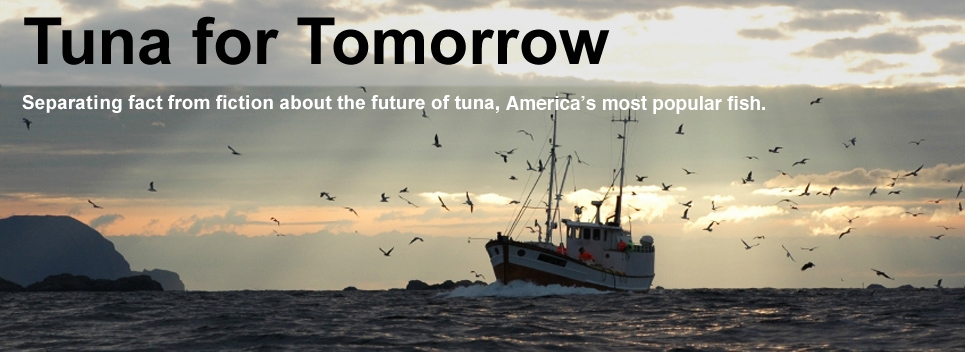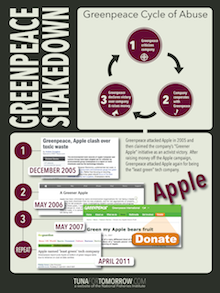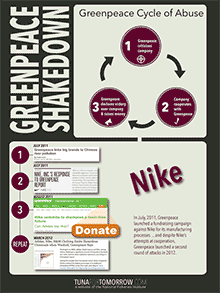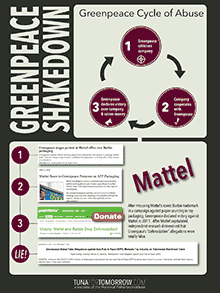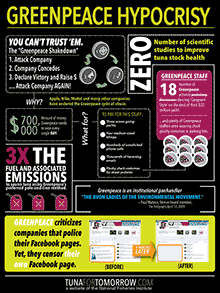Those whoтАЩve read GreenpeaceтАЩs latest histrionics тАФ Saving the oceans one tuna brand at a time тАФ are surely stupefied and left to wonder, what are they talking about?
To save you the pain of trying to navigate GreenpeaceтАЩs largely incoherent blog post, weтАЩve untangled a handful of the most nonsensical
ramblings:
Greenpeace makes it official: Giving up. Moving on.
Greenpeace writes, тАЬweтАЩve shifted our focus from pressuring politicians to campaigning where big business hurts the most тАФ the markets where they sell their products,тАЭ which really means that the tactic of trying to influence decision makers from up close has failed. Why? Because no one takes them seriously when they protest in silly costumes and deliver petitions ad nauseam that contain no substance.
Similarly, next week Greenpeace will picket outside the Western and Central Pacific Fisheries Commission (WCPFC) in Guam but wonтАЩt bother joining the International Seafood Sustainability FoundationтАЩs stakeholders meeting, also in Guam. Perhaps they feel theyтАЩve marginalized themselves to such an extent that sitting at the table with tuna sustainability heavyweights тАФ after just having shed sweaty, giant, plushy shark costumes in the lobby тАФ might highlight their status as fundraisers not real stakeholders?
Greenpeace uncovers the greatest conspiracy since the тАЬHollywood moon landing.тАЭ
Apparently, tuna companies тАЬwant to see [тАж] profits grow year after year until the tuna is gone and they can then move on to invest in some other species.тАЭ Seriously Greenpeace? Could they possibly believe that the canned tuna industryтАЩs business model hinges on decimating a millennia-old profession so it can тАЬmove onтАЭ? You donтАЩt need an MBA to realize that assertion is ludicrous.
Greenpeace promotes its solution in search of a problem.
As the posting spirals towards blather it produces interesting froth like this, тАЬskipjack tunaтАж would have a better chance of survival if it were caught using pole and line method of purse seine fishing [sic] without the use of Fish Aggregating Devices.тАЭ ThatтАЩs right, Greenpeace suggests that skipjack, a tuna specie that is healthy in every ocean on the planet would have a better chance of тАЬsurvivalтАЭ if fishing methods were altered. Despite the fact that no accredited or even slightly sensible fisheries scientist on Earth is suggesting that skipjack is going the way of the dodo, Greenpeace is fighting for its very survival. Is that meant to be hyperbole or humor?
Greenpeace wants cleaner air but simultaneously promotes fishing methods that will increase the carbon footprint.
Greenpeace thinks that тАЬif the numbers of tuna fishing vessels were to be reduced to levels that would allow fish populations to recover, we could have tuna and viable fishing industries for the future and cut the carbon footprint of the tuna fleets as well.тАЭ However, maintaining тАЬviable fishing industriesтАЭ with the FAD free fishing would actually increase the carbon footprint by four-fold. Banning FADs and promoting pole and line would mean that many more fishing boats would have to track this highly migratory species. With no way to attract tuna, fishing vessels would be forced to navigate the seas for much longer. How exactly does putting more boats on the water for longer periods of time тАЬcut the carbon footprintтАЭ?
These are just a few of the questions provoked by GreenpeaceтАЩs latest missive. We hope others тАФ journalists in particular тАФ are also asking, тАЬwhat is Greenpeace talking about?тАЭ


